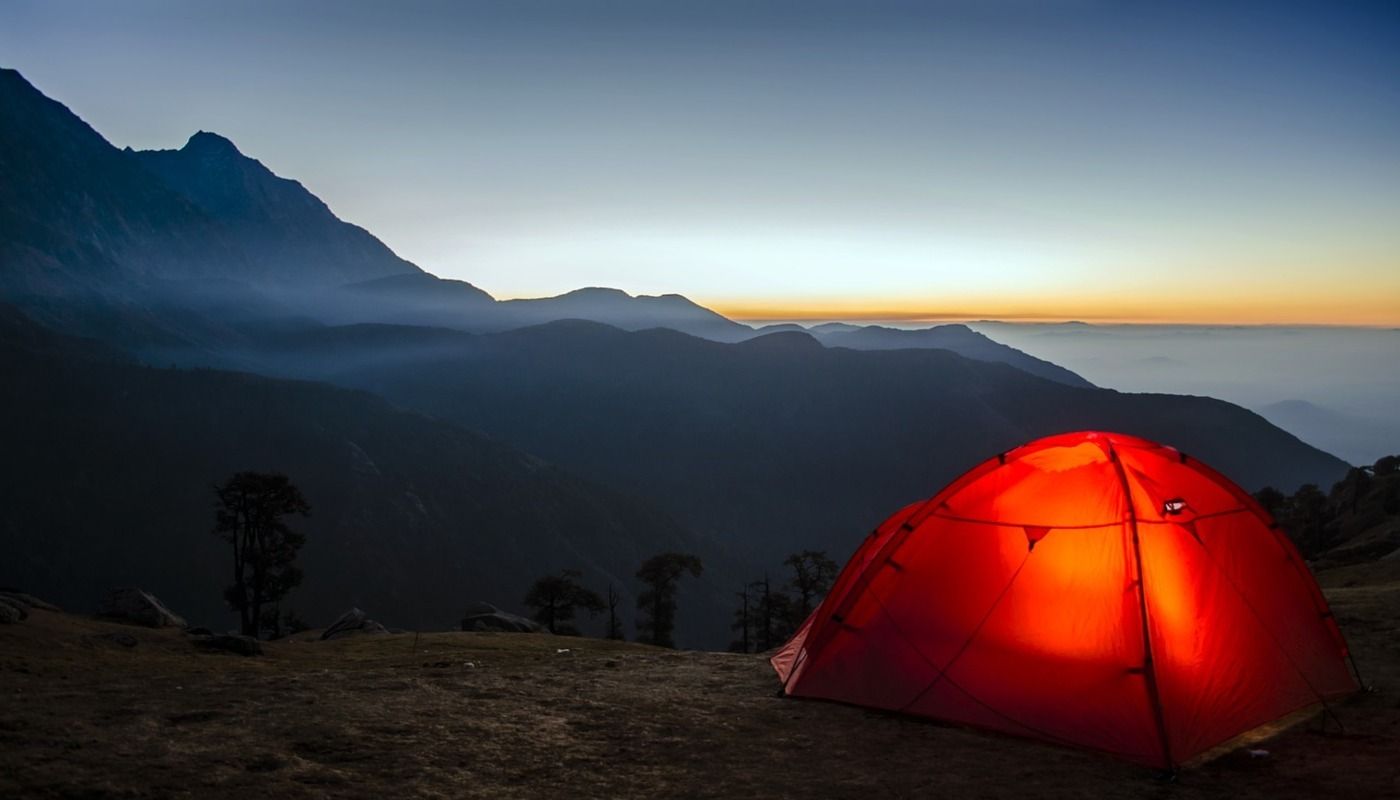A malfunctioning flashlight or a leaking tent may rapidly transform a nice, relaxing vacation into a nightmare. Regarding hiking tents, the best ones must provide weather protection for at least three seasons of whatever mother nature offers at elevations ranging from fifteen to one thousand five hundred meters above sea level.
All of this adaptability is not something that comes easily. Due to the large number of backpacking tents available on the market and their abundance, a tent is available to suit any taste and budget.
However, it also means that there are a large number of tents that are not up to the task. How are you meant to choose the best camping tent for your needs when hundreds of different types and sizes are available on the market? This is why I am, on the other hand, here to assist you.
The 7 Best Hiking Tents for the Outdoor Enthusiast In 2022
Having gone through the available alternatives and conducted extensive research, I have identified the top seven best hiking tents on the market that would suit a hiking enthusiast.
1. Big Agnes Copper Spur HV UL2 Tent
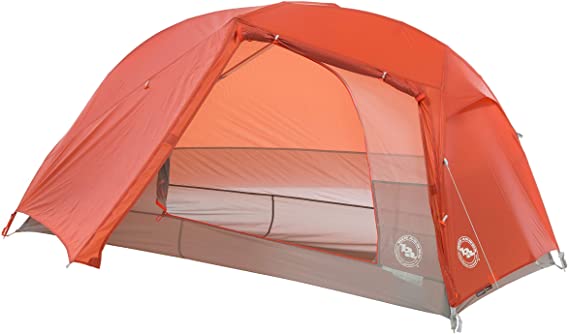
Features colour-coded clip construction, intuitive hub design, press-fit poles, and cross-pole sleeves that make set up a breeze.
The Copper Spur hiking tent was created by Big Agnes, who took several of our most essential backpacking tent factors and put them all together in one unit called the Copper Spur. This backpacking tent strikes an excellent balance between spaciousness, low weight, and ease of setup, making it one of the best backpacking tents available.
Keeping in mind, however, that the Copper Spur’s durability is a little behind that of the competition, it is a tent with a special prowess in striking balances and delivering just the right amount of comfort.
Aspects that are favourable to me about the beautifully crafted tent is that this overall tent was specially designed to strike a balance between weight, ease of use, and spaciousness, with the capacity of holding up to 2- persons (3P also available).
Remember that although the tent’s packed weight isn’t quite enough to earn it our top spot as our best overall backpacking tent, you’ll be hard-pressed to find a tent body that can fit into more scenarios than this hiking tent.
Highlighted Features:
- Reasonable low weight
- Spacious interior
- Simple assembly
- Well-ventilation.
2. REI Co-op Half Dome SL 2+ Tent

This tent’s rainfly is made up of strong materials that will keep you dry if it rains while hiking.
REI has been refining and improving its Half Dome tent series for years, and they have not failed to impress with its current generation. The Half Dome 2 SL+ (SL stands for Superlight), also known as the most effective 2-person backpacking tent, has become significantly lighter than its predecessors while maintaining one of the most spacious and comfortable tent interiors available on the market.
Furthermore, one thing I am certain of concerning this tent is that when it comes to its durability, this tent is an extremely sturdy piece and has been designed to last season after season with you.
Although no product is flawless, this tent is the closest thing to a sure thing on the market. This streamlined tent is designed for the backcountry, shedding weight at every turn to ensure you reach the summit with your back intact.
Highlighted Features:
- Very spacious, with plenty of storage space for gear or a furry friend
- Plenty of pockets
- Good headroom
- Lighter than REI’s standard Half Dome 2+
- Long-lasting construction
3. MSR Hubba 2
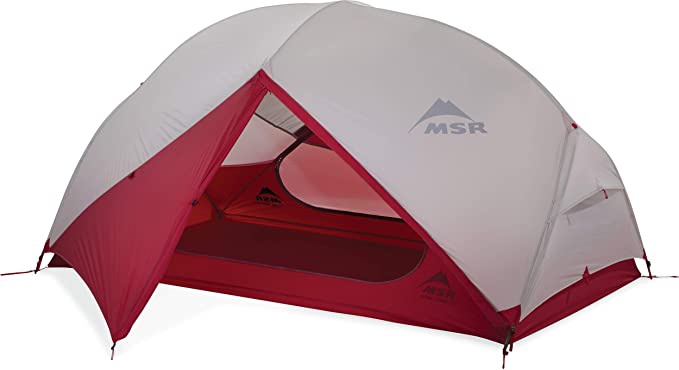
It has all the features that define modern backpacking tents and more. Easy to setup, you will surely love this tent.
The Hubba Hubba tent is a tank of a structure that has been recently renovated for the 2022 season. First and foremost, MSR reduced the overall weight of the backpack to 3 lbs. 4 oz. by removing a large amount of mass (from 3 lbs. 14oz. previously).
MSR’s Dura ShieldTM coating is significantly more durable than other waterproof treatments, and the composite poles are strong, can withstand severe winds, and can withstand years of camping use. These durable characteristics contribute to the tent’s weight remaining above 3 lbs, making it far from an ultralight alternative.
An ultra-lightweight hiking tent must provide shelter deep into the woods, and this tent makes it appear simple by giving a beautiful inside with plenty of space in an amazingly lightweight package.
Nonetheless, the MSR Hubba Hubba’s renowned durability may easily outweigh its weight, making it one of the best camping tents available, making this tent is one of the best for hiking and is the most durable you can find out there as its capabilities are 2-person tentacle (also available in 1-person)
Highlighted Features:
- Extremely sturdy
- Tough pole design
- Effective weatherproofing system
- Simple to set up
- Two doors for convenient access
4. Big Agnes Tiger Wall UI Solution-Dyed

It is designed to make your adventure comfortable, whether hiking, backpacking, going for a weekend or week-long trip.
The Tiger Wall UL is an excellent choice for those who like to move quickly and lightly (ultralight). It is possible to reduce the shelter’s weight to 1lb 14oz by reducing the number of posts and the footprint size; this amazingly light shelter provides outstanding durability and weather protection.
The rainfly vestibule also provides a small amount of extra space for your backpack, which will most likely not fit inside the tent with you anyhow.
For those who have many miles ahead of them and who are concerned with decreasing their pack weight, the Tiger Wall Ultralight hiking tent may be the perfect choice for their needs as it seats well as a one-person tent with also a version that suits perfectly as a 2-person tent is also available.
Highlighted Features:
- Lightweight
- Provides ample vestibule room for gear storage
- Simple to assemble
- Provides good ventilation
5. REI Arete ASL 2 Tent

This tent has a freestanding design, colour-coded clips and poles, low centre of gravity, which makes it ideal for hikers.
Are you unwilling to let a little cold and snow keep you from doing what you want? If that describes you, then closely examine the REI Arete ASL (all-season lightness). This tent is specifically intended to withstand snow and cold conditions above the treeline; winter hiking, snowshoeing, and backcountry skiing are all within easy reach when using this tent in the woods.
Even though it is not quite rugged enough for mountaineering, the REI Arete ASL shines in its woodland field and is one of the best tents for winter activities, according to the manufacturer.
Most popular hiking tents attempt to balance comfort and lightweight portability, but this tent does not. With one of the lowest packaged weights of any tent on our list, this behemoth has optimized every inch of its iconic offering to focus on being the best ultralight tent on the market.
Its capabilities hold up to 2 persons. These easy-to-pitch freestanding tents are ideal for hiking expeditions lasting more than a week and are equally at home on warm nights as on cold, rainy days.
Highlighted Features:
- Dependable year-round performance
- Reasonably priced for a 4-season tent
- Adjustable vents
6. The North Face Stormbreak 2
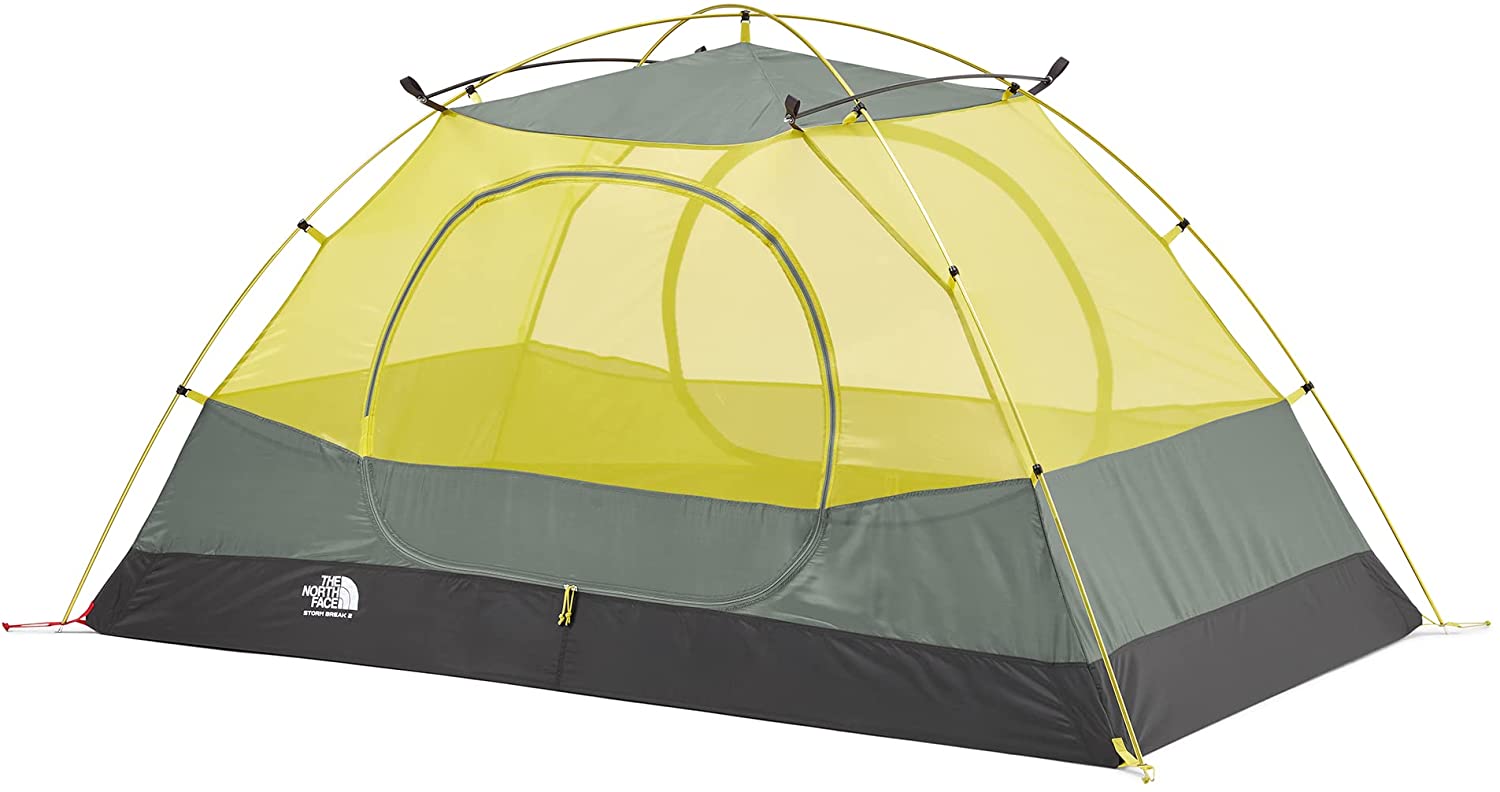
It features amazing design and lightweight and durable materials that will keep you safe and sound in any weather.
If you’re just getting started in hiking or are looking for a simple tent for infrequent trips, the Stormbreak 2 is an excellent choice. Even though it’s simple, with only a few functions and a mix of practical and heavy materials, it does the job at a fairly reasonable price.
Even while it isn’t going to survive as long as higher-quality tents, the Stormbreak 2 is unquestionably one of the best backpacking tents available for those looking for an entry-level alternative.
What this tent has ensured is the fact that getting and owning a very simple yet comfortable tent is not as difficult as with this tent; one can own it at the lowest price one can ever pay for a tent that has the capability of a 2-person tentacle.
There are many lighter tents designed for two people and a few more ultralight tents, but you’ll be hard-pressed to find another full tent bundle that performs as well as this one at such a low price. I recommend the best cheap backpacking tent with a footprint and plenty of inner space.
With this tent, you get the whole package, making it an excellent choice for the first tent for adventurers or a safe present to encourage a life outside. Most of the backpacking tents on our list have unique features and unusual designs that travellers will either love or despise, but not this one. This lightweight tent body has a rectangular shape and provides a discreet shelter that’s difficult to find fault with.
Highlighted Features:
- Very affordable
- Plenty of headroom
- Two entry doors
- Perfect as a present
7. Sea To Summit Telos TR2 Sea
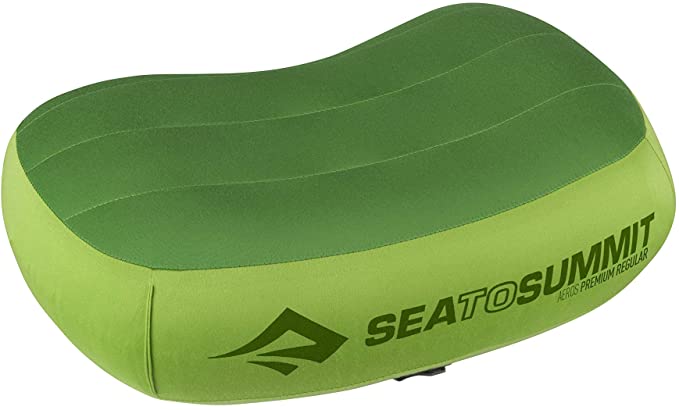
A lightweight and compact design that can provide you with everything you need without adding too much weight to your gear.
Sea to Summit made its debut in the world of hiking tents in 2021 with the Telos TR2, and they’ve already made a name for themselves because of the tent’s unusual shape; getting a closer look at this piece is a noticeable increase in headroom provided by the upward curving poles on the side of the tent, which, along with the wider doors, makes it a spacious alternative that still maintains a respectable packing weight.
The tent’s appeal is further enhanced by its adjustable ventilation and rainfly coverage (which allows for stargazing). For now, however, we’ll have to observe how the Telos and future Sea to Summit tents fare over time as a brand-new entry into the market; it is a 2-person tentacle.
Not every one of the greatest hiking tents needs to shatter weight records to be considered excellent. In addition to providing ample floor space, this tent includes a large rain flap that allows campers to stretch out after a hard day in the wilderness. In addition to being comfy, this system is extremely long-lasting and reliable.
On these semi-freestanding tents, you can customize the weather protection to add additional ventilation, wind resistance, and enough internal space to play cards on a wet afternoon. Lighter tents are available, but a smaller tent may be a better option if weight isn’t your primary issue.
Highlighted Features:
- A new design geometry that maximizes the size of the door and the internal area
- The weight that is reasonable for a 2-person tent
- A well-thought-out and durable design
Are Lightweight Tents Always the Best Choice for Hiking?
While lightweight tents have their advantages, they may not always be the best choice for hiking. The decision depends on various factors. Lightweight tents are favoured by hikers who prioritize minimizing pack weight and value fast and efficient setups. They are particularly beneficial for long-distance backpacking or thru-hiking, where every ounce matters. However, lightweight tents often sacrifice durability, spaciousness, and weather resistance.
They are typically designed for fair weather conditions and may struggle in harsher environments. If you frequently hike in challenging terrain or encounter unpredictable weather, a slightly heavier tent with enhanced features, such as stronger materials, sturdy poles, and better rainfly coverage, may be a wiser choice. It’s crucial to assess your specific hiking needs, considering factors like climate, duration of trips, and personal preferences. Balancing weight, durability, and functionality is key when choosing the best tent for hiking.
How Many People Should a Typical Hiking Tent Accommodate?
A typical hiking tent is designed to comfortably accommodate a specific number of people. The manufacturer indicates the size and capacity of a hiking tent which are typically mentioned in the product specifications. Common options include 1-person, 2-person, 3-person, and larger tents.
When deciding how many people a hiking tent should accommodate, it’s important to consider several factors. First, consider the number of individuals who will be sharing the tent. If you’re hiking solo, a 1-person tent should suffice. For couples, a 2-person tent offers a cosy fit. If you plan to hike with a group or desire extra space, a 3-person or larger tent may be more suitable.
Remember that the tent’s capacity refers to the number of individuals who can sleep side-by-side on the tent floor. It doesn’t account for additional gear storage or personal space. If you prefer more room or have extra gear, consider opting for a larger tent than the suggested capacity.
Ultimately, selecting the appropriate size of a hiking tent depends on your preferences, the number of people sharing the tent, and the level of comfort you desire during your hiking adventures.
What are The Essential Features to Look for In a High-quality Hiking Tent?
- Weight and Portability: Every ounce matters when you’re hiking long distances. Look for a hiking tent that strikes a balance between weight and durability. Ultralight tents are ideal for backpackers, but they may sacrifice some sturdiness. Consider the materials used, such as lightweight and durable fabrics, aluminium or carbon fibre poles, and lightweight stakes. A portable tent that can be easily packed into a compact size will make your hiking experience more comfortable.
- Weather Resistance: One of the primary functions of a hiking tent is to protect you from the elements. A high-quality tent should be designed to withstand various weather conditions. Look for features like a waterproof rainfly made of durable materials with a high hydrostatic rating. Additionally, a bathtub-style floor construction helps prevent water from seeping in through the seams. Reinforced stitching and taped seams also enhance the tent’s ability to keep you dry during rainstorms.
- Ventilation: Proper ventilation is crucial to prevent condensation buildup inside the tent. Look for a tent with mesh panels or windows allowing adequate airflow. These features promote breathability, reduce condensation, and enhance comfort while camping. A tent with adjustable vents or rainfly options can provide additional control over airflow, ensuring a pleasant environment inside the tent.
- Interior Space and Design: Consider the interior space and layout of the tent. A high-quality hiking tent should provide sufficient space for you and your gear while maintaining a compact and lightweight design. Look for tents with vertical sidewalls that maximize the usable space and allow for sitting up comfortably. Multiple doors and vestibules offer convenient entry and storage options, preventing clutter inside the sleeping area.
- Durability and Longevity: Investing in a hiking tent is an investment in your outdoor adventures. Look for tents constructed with high-quality materials and sturdy components. Ripstop nylon or polyester fabrics are known for their durability and resistance to tears. Reinforced poles, robust zippers, and well-designed guylines and stakes contribute to the tent’s overall strength and longevity.
- Easy Setup: After a long day of hiking, setting up camp should be a straightforward and quick process. Look for tents that come with intuitive and easy-to-follow setup instructions. Freestanding tents, which can be pitched without stakes, offer versatility and convenience. Color-coded poles, clips, and quick-release buckles can simplify the setup process, especially in challenging weather conditions.
How Can I Set Up My Hiking Tent Properly?
When it comes to spending a night amidst the serene wilderness, having a reliable and well-pitched hiking tent becomes your sanctuary in the great outdoors. But here’s the catch: properly setting up a tent is an essential skill every hiker must possess.
Step 1: Choose the Right Campsite
Selecting an appropriate campsite is the first step towards setting up your hiking tent. Look for a dry area with good drainage to avoid water accumulation during rainstorms.
Avoid setting up your tent directly under trees with dead or overhanging branches, as they pose a risk of falling. Additionally, consider the direction of the wind and position your tent accordingly to minimize exposure.
Step 2: Clear the Ground
Before pitching your tent, clear the area of any debris, rocks, sticks, or sharp objects that could damage the tent floor. Remove larger rocks or roots that could cause discomfort while sleeping. Smooth out the ground surface as much as possible to ensure a comfortable sleeping area.
Step 3: Lay Out the Tent
Unpack your tent and lay out all the components. Start by spreading the tent body flat on the ground, aligning it with the chosen campsite.
Make sure the zippers and openings are in the desired direction, such as facing away from prevailing winds or towards a scenic view.
Step 4: Assemble Tent Poles
If your tent features poles, assemble them according to the manufacturer’s instructions. Usually, tent poles are color-coded for easy identification.
Connect the sections and slide them through the designated pole sleeves or attach them to the tent body using clips or hooks. Ensure that the poles are securely fitted to provide structural integrity.
Step 5: Stake Down the Tent
Most tents come with stakes or pegs to secure them to the ground. Start by inserting the stakes through the designated loops or rings at the corners of the tent body.
Angle the stakes away from the tent, pointing them towards the ground at a 45-degree angle. Use a rock or mallet to drive the stakes into the ground until they are secure.
Step 6: Attach Rainfly
If your tent includes a rainfly, now is the time to attach it. The rainfly adds an extra layer of protection against rain and wind. Align the rainfly over the tent body, ensuring it covers the entire structure.
Fasten the clips, buckles, or hooks to secure the rainfly to the tent poles or body. Tuck in any excess fabric to prevent water from pooling.
Step 7: Adjust and Tension
Once the rainfly is attached, it’s essential to adjust and tension the tent properly. Begin by going inside the tent and pushing up on the centre to create more headspace and prevent the tent from sagging.
Ensure the tent walls are taut, improving stability and wind resistance. Adjust the stakes and guylines to achieve proper tension, ensuring the tent is firmly anchored.
Step 8: Test the Setup
Before settling in for the night, it’s a good idea to test the tent setup. Enter the tent and assess its stability. Sit or lie down inside to check for comfort and adequate space.
Ensure that the tent is securely pitched and all components are properly attached. Make any necessary adjustments or tweaks to enhance the setup.
Are Freestanding or Non-freestanding Tents Better for Hiking, and Why?
Both freestanding and non-freestanding tents have advantages and suitability for different hiking scenarios. Freestanding tents are designed with a built-in structure, typically utilizing tent poles, allowing them to stand independently without the need for stakes or guy lines. On the other hand, non-freestanding tents rely on stakes and guy lines for support and stability.
Freestanding tents offer convenience and ease of setup. They can be quickly assembled and repositioned, making them ideal for hikers who frequently change camping spots or camp on rocky or hard surfaces where staking can be challenging. Freestanding tents also have more headroom and interior space, providing a comfortable living area during extended trips.
Non-freestanding tents, although requiring more effort to set up, excel in weight savings. They are typically lighter than freestanding tents because they eliminate the weight of built-in poles. This advantage is especially crucial for ultralight backpackers or those embarking on long-distance hikes where reducing pack weight is a priority.
The choice between freestanding and non-freestanding tents ultimately depends on personal preferences, camping conditions, and the specific needs of the hiker. Freestanding tents offer convenience and stability, while non-freestanding tents prioritize weight savings. Considering the terrain, weather conditions, duration of trips, and personal camping style will help determine which type of tent is better suited for a particular hiking adventure.
Conclusion
Ultimately, I have shown that the perfect camping tent can be found in various styles and weights, ranging from minimalist ultralight shelters to affordable, heavy entry-level variants.
The ideal tent for beginners and those taking shorter trips differs significantly from that for thru-hikers concerned with every ounce of weight they can save. I have compiled a list of the best hiking tent after extensive research.
Now with these several models here for the sake of comparison and with other available capacities listed in the specifications and outstanding features, I am certain you will have little or no stress with making the perfect purchase that suits your budget and your needs.
